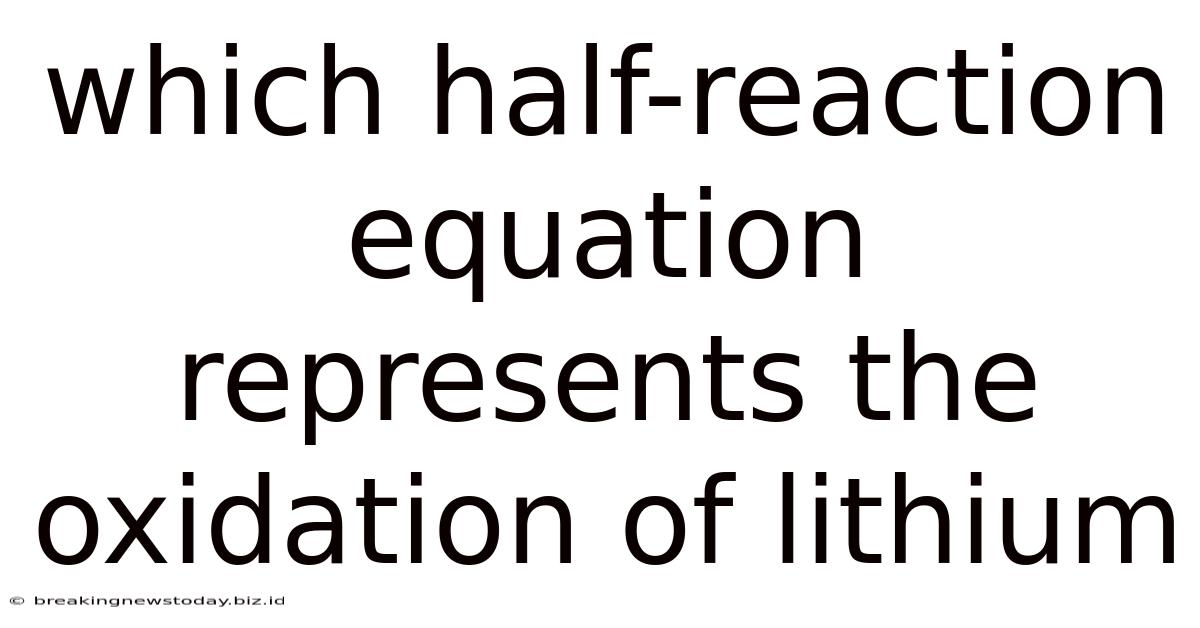Which Half-reaction Equation Represents The Oxidation Of Lithium
Breaking News Today
Jun 06, 2025 · 4 min read

Table of Contents
Which Half-Reaction Equation Represents the Oxidation of Lithium?
Understanding oxidation and reduction reactions, often shortened to redox reactions, is fundamental in chemistry. These reactions involve the transfer of electrons between species. Oxidation is defined as the loss of electrons, while reduction is the gain of electrons. This article will delve into the specifics of lithium oxidation, examining the correct half-reaction equation and exploring the underlying principles.
Understanding Oxidation States and Redox Reactions
Before we identify the half-reaction for lithium oxidation, let's clarify some key concepts:
-
Oxidation State: This represents the hypothetical charge an atom would have if all bonds to atoms of different elements were 100% ionic. It's a crucial tool for tracking electron transfer in redox reactions. For example, in LiCl, lithium (Li) has an oxidation state of +1, while chlorine (Cl) has an oxidation state of -1.
-
Redox Reactions: These are reactions where the oxidation states of atoms change. One species undergoes oxidation (loses electrons, oxidation state increases), while another undergoes reduction (gains electrons, oxidation state decreases). These reactions always occur simultaneously; you cannot have oxidation without reduction, and vice versa.
-
Half-Reactions: To analyze redox reactions effectively, we break them down into two half-reactions: one representing oxidation and the other reduction. These half-reactions show the electron transfer explicitly.
Identifying the Oxidation Half-Reaction for Lithium
Lithium (Li) is an alkali metal, highly reactive due to its single valence electron. It readily loses this electron to achieve a stable, noble gas electron configuration. This electron loss is the defining characteristic of lithium oxidation.
The correct half-reaction equation representing the oxidation of lithium is:
Li(s) → Li⁺(aq) + e⁻
Let's break this down:
-
Li(s): This represents lithium in its solid elemental state. Its oxidation state is 0.
-
Li⁺(aq): This represents a lithium ion in an aqueous solution. It carries a +1 charge, indicating it has lost one electron. Its oxidation state is +1.
-
e⁻: This represents the electron that has been lost during the oxidation process.
This equation clearly shows the loss of one electron from a neutral lithium atom, resulting in a positively charged lithium ion. The increase in oxidation state from 0 to +1 confirms the oxidation process.
Incorrect Half-Reactions and Why They're Wrong
It's important to understand why other potential half-reactions are incorrect. Let's examine some common misconceptions:
-
Li⁺(aq) → Li(s) + e⁻: This equation represents the reduction of lithium, not oxidation. It shows a lithium ion gaining an electron to become a neutral lithium atom. The oxidation state decreases from +1 to 0.
-
2Li(s) → Li₂⁺(aq) + 2e⁻: This is incorrect because lithium typically forms a +1 ion, not a +2 ion. Lithium's electronic configuration makes it energetically unfavorable to lose two electrons.
-
Li(s) + e⁻ → Li⁻(aq): This equation represents the formation of a lithium anion (Li⁻), which is highly improbable under normal conditions. Lithium's strong tendency is to lose, not gain, electrons.
Applications of Lithium Oxidation
The oxidation of lithium is crucial in several important applications:
1. Lithium-ion Batteries
This is perhaps the most well-known application. In lithium-ion batteries, lithium atoms undergo oxidation at the anode (negative electrode) during discharge. The released electrons flow through the external circuit, powering devices. Simultaneously, a reduction reaction occurs at the cathode (positive electrode). The process reverses during charging.
2. Electrochemical Synthesis
Lithium's strong reducing power, a direct consequence of its ease of oxidation, makes it useful in various electrochemical synthesis reactions. It can act as a reducing agent to prepare other compounds.
3. Organic Chemistry
Lithium reagents are often used in organic chemistry due to their ability to donate electrons and initiate reactions. Their oxidation is part of the overall reaction mechanism.
Connecting Oxidation of Lithium to Other Redox Reactions
To fully grasp the significance of lithium's oxidation, it's helpful to consider it in the context of a complete redox reaction. Let's imagine lithium reacting with water:
2Li(s) + 2H₂O(l) → 2LiOH(aq) + H₂(g)
This reaction can be broken down into two half-reactions:
Oxidation (Lithium): 2Li(s) → 2Li⁺(aq) + 2e⁻
Reduction (Water): 2H₂O(l) + 2e⁻ → 2OH⁻(aq) + H₂(g)
Notice that the oxidation half-reaction is identical to the one we discussed previously, except it's multiplied by two to balance the electrons transferred. The electrons released during lithium's oxidation are consumed by water during its reduction. This balanced equation emphasizes the simultaneous nature of oxidation and reduction in redox reactions.
Conclusion: Mastering the Oxidation of Lithium
Understanding the half-reaction equation for lithium oxidation – Li(s) → Li⁺(aq) + e⁻ – is key to comprehending its reactivity and its importance in various scientific and technological fields. By correctly identifying this half-reaction and appreciating the broader context of redox chemistry, we can better understand the fundamental principles governing many chemical processes, from battery technology to organic synthesis. Remembering the increase in oxidation state from 0 to +1 is a helpful mnemonic for confirming the oxidation process. This knowledge forms a robust foundation for further exploration of redox reactions and their diverse applications.
Latest Posts
Latest Posts
-
Match Each Property Of A Liquid To What It Indicates
Jun 06, 2025
-
Which Delivery System Requires Friction To Release The Performance Ingredients
Jun 06, 2025
-
Unit 8 Quadratic Equations Homework 1 Answer Key
Jun 06, 2025
-
Which Of The Following Has Uniform Stress
Jun 06, 2025
-
Which Expression Is Equivalent To 4y2 3 3y 2
Jun 06, 2025
Related Post
Thank you for visiting our website which covers about Which Half-reaction Equation Represents The Oxidation Of Lithium . We hope the information provided has been useful to you. Feel free to contact us if you have any questions or need further assistance. See you next time and don't miss to bookmark.